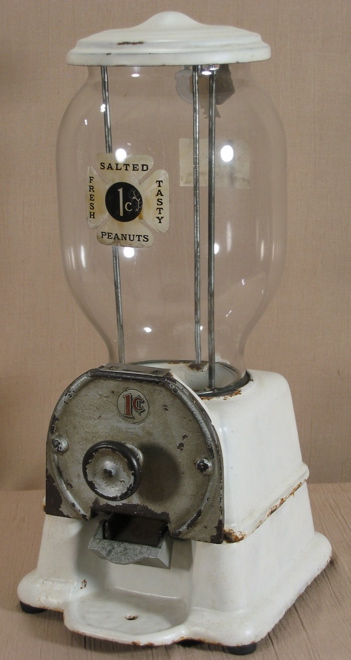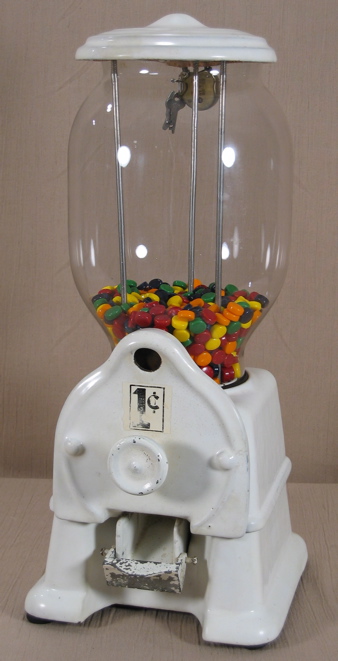___________________________________________________________________________________________
Northwestern Peanut Merchandiser


___________________________________________________________________________________________


Northwestern Corporation, Morris, IL, c. 1920's, 17 1/2". According to Silent Salesmen Too, this was Northwestern's first globe machine. Their ads said it was "made to last forever." Merchandisers' claim to excellence is that the product touched only glass and porcelain---never metal---and that Merchandisers were therefore more sanitary than other vendors. Most collectors associate Northwestern machines with porcelain based on later models such as the 33 Peanut, 33 Ball Gum, and Model 39, and it's interesting to note that Northwestern's love of porcelain started with their first globe machine.
Merchandisers are made of painted or porcelainized cast iron, with the painted versions almost certainly being the earlier of the two. They came in at least 3 versions, one of them considered earlier and two of them considered variations of the later version. The version pictured above left---a porcelainized example with a flat coin entry and a painted front plate---is the earlier version and is considered rare, with (to the best of my knowledge) only 2 or 3 examples known to still exist. An example of the later versions is pictured above right. Both of the later versions have a raised coin entry and a porcelainized front plate, and some examples have a different knob from that of the early version. Most of the later versions have a dish under the gate; the example pictured above right does not have that dish and is the only one I know of that doesn't. This represents a difference in the castings, so I consider this to be a variation in the model. I don't know whether the dished or undished version is earlier; I could make a case for either, but I'd be speculating. The globe on all versions is the same as that on the Advance Hilo.
In the mid-1990's the late California dealer Steve Perry stumbled across a stash of 6 Merchandisers. They were the later version with raised, porcelainized coin entries and dishes, and that discovery brought the number of known examples to about 10 or 11. Some machines in that stash were white porcelain and some were lavender or mauve porcelain (take your pick). The lavender on those machines is the only shade of its kind that I've seen on an old vendor. There's some controversy over whether it was the original color or whether it's an effect of age or sun, but I've seen several of these machines and for 3 reasons believe it's the original color: 1) The color is even across the entire surface of the machines, which I wouldn't expect from a change based on sun or atmospheric exposure, 2) White porcelain machines and mauve porcelain machines were found at the same time in the same place, which (again) I wouldn't expect from a change based on sun or atmospheric exposure, and 3) I've not seen any other example of white porcelain turning to lavender porcelain over time.
Bill Enes said he once talked to a man who worked for an operator who ran 1,000 of these machines, which if true means that 99% of them have disappeared over the years. That's a pretty high loss rate, so we should at least consider the possibility that the man Bill spoke to is wrong. This is such a solid machine that I can't imagine that high a loss rate without a campaign designed specifically to cleanse the earth of their presence.
The examples pictured above is 100% original except for probably the 1 cent decal on the machine on the right. The machine on the left is the machine pictured on Silent Salesmen Too page 108, and is one of my favorite machines. It has a neat "call for service" tag in the back, seen here.
Many thanks to Dan Davids (a.k.a. "Mr. Northwestern") for his critical review and content suggestions.
___________________________________________________________________________________________
___________________________________________________________________________________________
©Small Vintage Vending 2009